Fighting for the Right to Know
Exposure to pesticides harms the health farming communities. Now those communities want to know when pesticides will be applied. Luis Melecio-Zambrano, reports. Illustrations by Olivia Raster and Jonathan Broberg
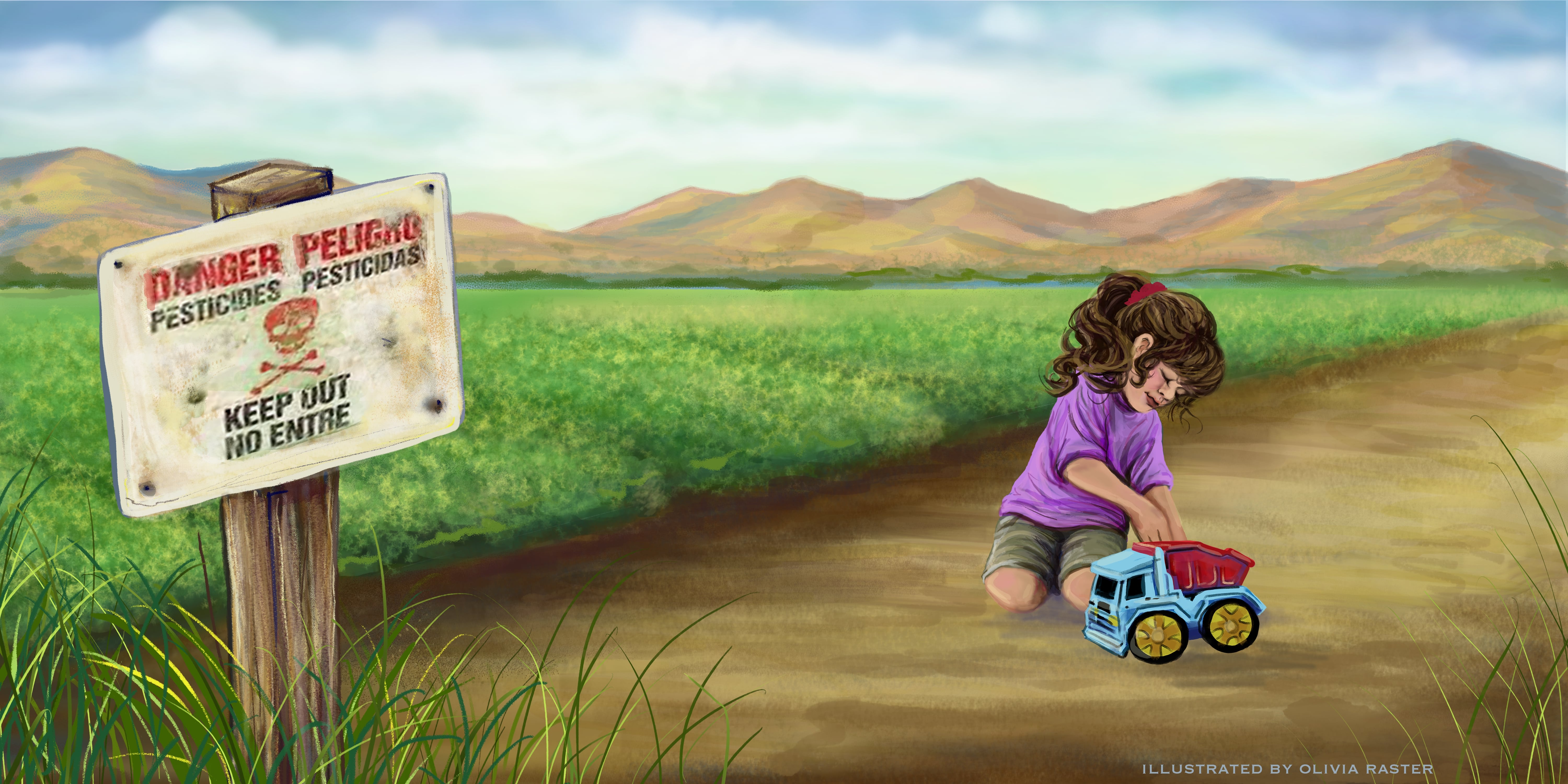
Illustration: Olivia Raster
On a warm February day in 2017, Victor Julian Torres smelled something strange. Not quite rotten egg. Skunky. Sweet, maybe. The scent wafted into his portable at Vista Verde Middle School, drifting in through the windows that were propped open to air out the muggy classroom.
Suddenly, Victor’s ten-year-old lungs struggled to hold on to air, each breath yielding less than it should have. Though he lived with asthma, he didn’t know what could have triggered this attack. A school nurse called his family, who called an ambulance; his mother rode with him as the vehicle raced past the fields of grapes that surrounded Victor’s school. Finally, they arrived at a hospital, where doctors administered a breathing treatment and pain medication to help stabilize Victor. The doctors told Victor that he’d had a close call: if he’d arrived any later, he would have been hospitalized for days. Victor recalls the doctors’ words: “This was a major asthma attack. It was a miracle that you were able to fight it off.”
Victor’s mother, Yanely Martinez, blames pesticides for her son’s asthma attack, as well as for the burden of cancer and developmental disability in her community. She points to studies that link exposure to certain pesticides with poorer brain and lung function. California’s farmers apply some 39 million pounds of pesticides every year, helping power the most productive agricultural state in the country. But with the risk of pesticide exposure, more and more Californians like Martinez argue that this comes at the cost of the health of rural farming communities — which, in California, are heavily low-income and Latino.
Now, Martinez and other activists have joined a statewide movement demanding that farmers and government officials provide advance warning before they apply pesticides to their fields. The movement has already scored a victory, convincing California regulators to test new systems for alerting residents of nearby pesticide applications. While regulators claim these pesticide notification programs aim only to increase transparency, activists say these will be a crucial tool to protect themselves and their communities from the dangerous health effects that can result from pesticide exposure.
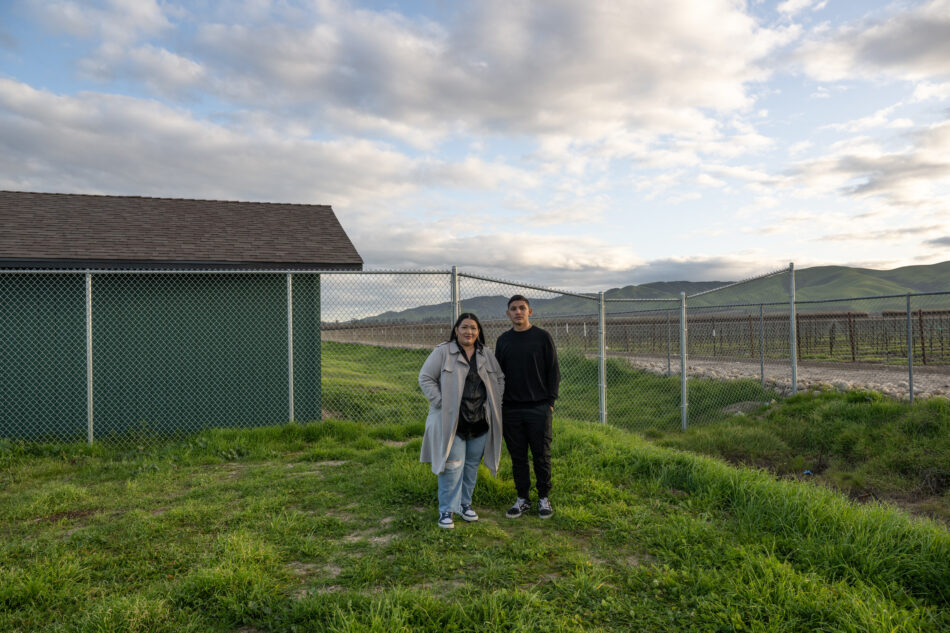
Yanely Martinez (left) and Victor Julian Torres (right) stand in the space between Vista Verde Middle School and the neighboring grape fields. Photo – Chris Schodt
“DANGER DO NOT ENTER”
The fight for pesticide notification began in Monterey County over 50 years ago when a string of farmworkers in the county experienced dizziness, vomiting, breathing difficulties and slow heart rates after working in fields where pesticides had been applied. In 1981, a coalition of activists pushed the agricultural commissioner in Monterey County to require signs to be posted on fields after pesticide application. Two years later, state regulators required California farmers to post white signs, emblazoned with the words “DANGER DO NOT ENTER” in English and Spanish over a bright red image of a skull and crossbones, after applying pesticides. The signs were supposed to warn farmworkers and help protect them from exposure in the fields.
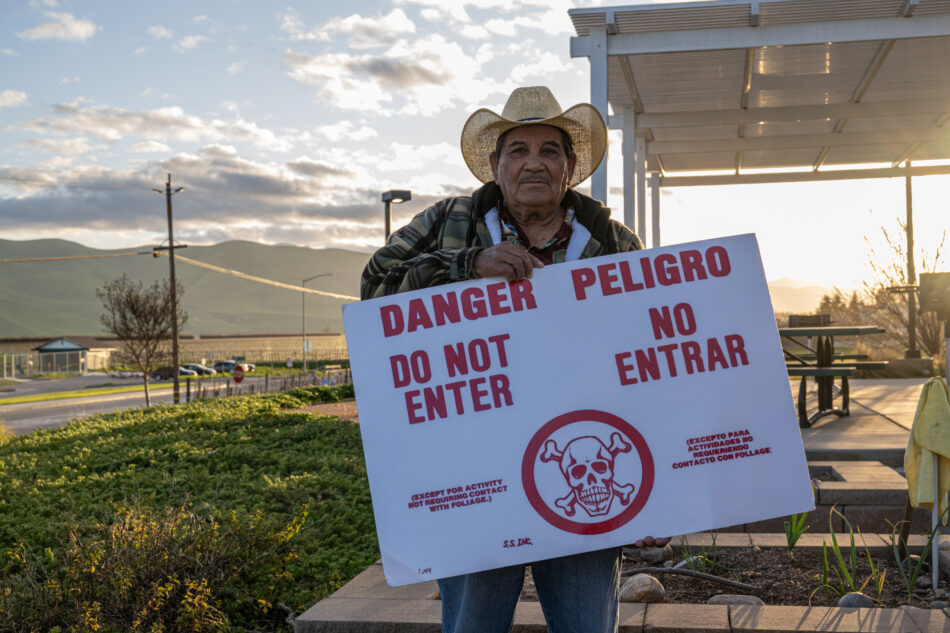
Ramon Martinez, Yanely Martinez’s father, holds a copy of a pesticide notification sign. The elder Martinez was a farmworker in Greenfield from 1974-2012. “They would spray the grapes, and then we would see the skull and knew we couldn’t enter,” he says. Photo – Chris Schodt
The current push for notification began with three schools in the Pajaro Valley, says Mark Weller, organizing director of Californians for Pesticide Reform, a non-profit that advocates for stricter pesticide regulation. After a pesticide monitoring device there registered several instances of potentially dangerous levels of the pesticide Telone in the air, a coalition of schools in the valley pressed their agricultural commissioner to notify them when nearby fields were applying pesticides. Their success sparked a local push that spread across the school district, then across the state. In 2021, Governor Gavin Newsom gave the California Department of Pesticide Regulation $10 million to make a statewide notification system. According to a statement by the department, the program aims to “advance environmental justice and … protect public health” by “providing transparent and equitable access to information.”
The resulting notification system will be a far cry from the posted skull and crossbones. The system proposed by state regulators would collect data on when farmers are going to apply pesticides, then display it on a public website that shows where pesticides are going to be applied. This system would be the first of its kind in the world.
In order to test the system, the pesticide regulator ran four pilot projects in conjunction with county agricultural commissioners across the state starting in early 2022. In select areas, residents could sign up to receive notifications from the county when pesticides were being applied. When farmers told the county about an upcoming application, the county forwarded this information to the public via text, email or smartphone app anywhere from 7-36 hours before application. The notifications included the name of the pesticide and the time of application, as well as application method, in some pilots (Pesticides are not always sprayed and are often injected in the ground or dispensed as a gas under tarps.) Based on early results of the pilots and public feedback, state regulators aim to have the finalized notification project active throughout California by 2024.
“It’s not perfect by any means, but it’s a first step and hopefully it will help to guide what the state is going to implement in the future,” said Juan Hidalgo, the former Santa Cruz County Agricultural commissioner, who ran the pilot project in Watsonville.
“Transparent and Equitable”
After Victor’s asthma attack, Martinez tried to discover what had triggered her son’s asthma. So she asked the Santa Cruz County agricultural commissioner what pesticides had been applied on the nearby fields that day. The report from the commissioner didn’t arrive until the next month. “A month? How am I going to protect my child if I get the information a month after?” says Martinez.
Even when she finally did get the information, the report held a confusing tangle of chemical formulae. “It was just nothing but numbers and words I couldn’t even pronounce … I couldn’t understand anything,” says Martinez. “So I was frustrated.”
Martinez consulted with scientists from Californians for Pesticide Reform, where she now works as a community organizer. After looking through the document Martinez had received from the county, the non-profit told her that ten pesticides had been applied near Vista Verde Middle School on the morning of Victor’s asthma attack. Seven of them could induce asthma attacks, they told her. “If I would have known as a mother, believe me, Victor being asthmatic, I wouldn’t have sent him to school that day,” says Martinez.
With a notification system, people like her could make those sorts of health decisions for themselves, Martinez says. People could use the information from notifications differently, depending on their circumstances. Some might bring toys and laundry in from outdoors and shut their doors and windows. Others might avoid areas near pesticide application altogether, for instance, by pulling kids out of school or even changing their jogging or commuting routes.
That isn’t possible in some of the pilot notification systems, which require farmers to give agricultural commissioners 48 hours advance notice, only have a resolution of 1 square mile and only include a highly-regulated class of pesticides known as restricted pesticides.
Activists have proposed a range of measures to make pesticide notifications more useful for their communities. Their proposals include requiring regulators to provide 72-hour advanced notice before applications, providing the exact location of pesticide applications and providing notifications in Mixtec, Zapoteco and Trique, indigenous Mexican languages spoken by many farmers. “Ten million dollars is a lot of money, and if we’re not getting an exact location, we’re not getting our money’s worth,” said pesticide reform advocate Francisco Rodriguez at a virtual public hearing in 2022, referring to the money allocated for the notification program.
Many at the hearing also called for pesticide regulators to include a broader range of pesticides in the notification program and to allow community members to access the notifications anonymously, without providing their addresses, which was required to sign up for the notifications in some pilots.
However, regulators indicate that they are unlikely to meet many of these demands. In an interview, California Department of Pesticide Regulation representative Leia Bailey suggested that anonymous access to notifications should be included but made no mention of the state building a new reporting system that could support site-specific notification.
“Many people did feel sick”
Yanely Martinez has lived in Greenfield for nearly forty years, when her parents moved here to work in the fields of the southern Salinas Valley. Here, nestled between the bright green hills and the mountains of Pinnacles National Park, she raises her four children, helps care for her parents and serves as a councilmember for the city.
Standing among the beds of pruned rosebushes and sprawling yerba buena in her father’s garden, Martinez introduces her mother’s caretaker, Gabriela Chavez. Chavez worked as a farmworker for years before becoming a caretaker and has her own stories of pesticide exposure. “The tractors would go … applying chemicals on the grapes, and then we would follow behind, working,” recalls Chavez in Spanish. “Many people did feel sick or get headaches.”
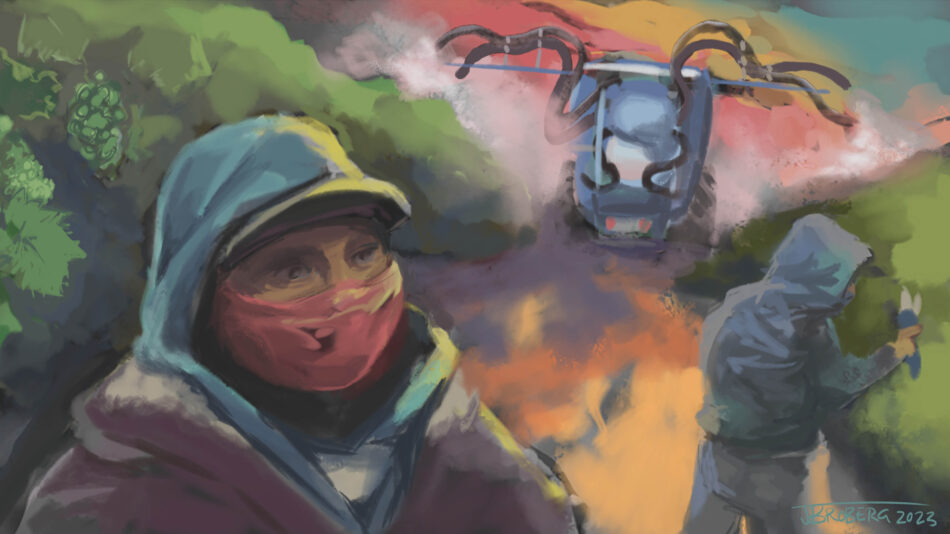
Some farmworkers, like Gabriella Chavez, were exposed to pesticides while working in the fields. Illustration – Jonathan Broberg
In part because of her experience in the fields, Chavez enrolled herself and her children in the Center for the Health Assessment of Mothers and Children in Salinas, or CHAMACOS, study run by researchers at University of California, Berkeley. Over two decades, CHAMACOS (meaning “little children” in Spanish) has published almost 200 papers examining the effects of environmental exposure on health outcomes of some 800 children — including Chavez’s — from the womb to adulthood.
The CHAMACOS study’s findings paint a worrying picture of how pesticides may harm children’s health and development. CHAMACOS found that prenatal and early childhood exposure to certain pesticides was associated with poorer attention, poorer brain development in early childhood, poorer lung function, poorer cognitive function, higher incidence of obesity in boys and lower birth weight in infants. Members of the CHAMACOS cohort showed higher pesticide exposure than people in a national study not restricted to members of agricultural communities, which helped confirm that this exposure was due to their proximity to the fields and not exposure through food.
The CHAMACOS study also found that people who lived closer to agricultural fields were more likely to suffer health problems. People who lived anywhere from 60 meters to 8 km (about 200 ft to about 5 miles) felt the negative effects of exposure depending on the type of pesticide and the application method.
Since agricultural communities are disproportionately Latino, these health effects fall unevenly. Some 96% of California farm workers are Latino, and Greenfield, for example, where Yanely Martinez lives, is over 90% Latino. This means that over half of pesticides in California are applied in the California zip codes with the highest proportion of people of color, according to a study by the state of California. That same analysis found that pesticide pollution has more racial, ethnic and income disparities than any other type of pollution in California. Another analysis by Californians for Pesticide Reform found that majority Latino counties had nearly 10 times as much of the pesticide Telone applied compared to counties with low Latino populations. “When you’re spraying … pesticides in a location — when it’s mostly Latino and you don’t want to be transparent about it, I would say that’s a good formula for environmental racism,” says Ann Lopez, executive director of the Center for Farmworker Families, a farmworker advocacy non-profit in Watsonville, California.
Brenda Eskenazi, who led CHAMACOS, acknowledges these disproportionate impacts and understands how communities who look at CHAMACOS might be frightened by the results. However, she cautions that each pesticide is unique, and that scientists haven’t yet studied many pesticides that farmers now use. This means that scientists don’t yet understand how people may be affected by commonly used pesticides or how doctors can best treat exposure. Given this, Eskenazi questions whether notification really helps communities, or just adds to their anxiety without giving them the proper tools to improve their public health. “There’s a flip side of a right to know,” says Eskenazi. She thinks scientists, advocates and regulators should instead work to reduce pesticide use by regulating pesticides, researching pesticides, using more sustainable pest management and making it cheaper to go organic. “Those are the things we really need to be working on,” she says.
To their credit, many advocates, Martinez and Weller included, agree with Eskenazi’s goals. They fight for stricter pesticide regulation across the board and have achieved some successes. But, these successes have been piecemeal, such as the banning of Chlorpyrifos or the recently proposed restriction of Telone. Further, these individual fights can take decades, says Weller, and the incremental improvements reflect the state’s unwillingness to take on broader, stricter regulation. (He points to the European Union, which has banned several dozen pesticides which farmers commonly apply in California, as an example of stricter regulation.) Pesticide notification is one of the few regulatory actions on the table that will cover a broad swath of pesticides. So activists argue that this will allow citizens to take their safety into their own hands, even if it isn’t the type of regulation that might most directly address activists’ concerns. “That’s always the preferred way: to have our government actually … protect public health and not be racist about it,” says Weller of Californians for Pesticide Reform. “Unfortunately, that’s just not what we have right now.”
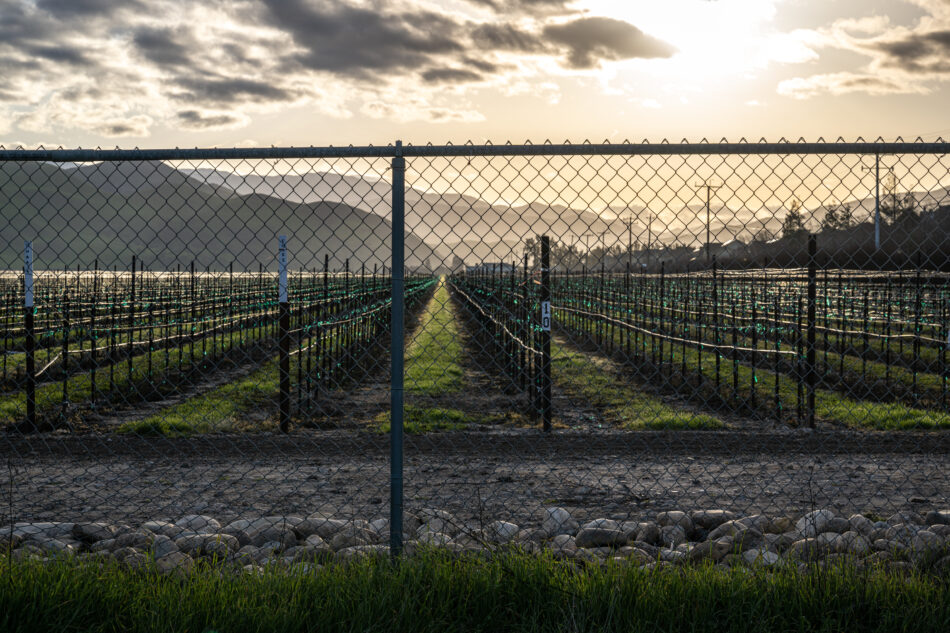
Like much of Greenfield, Vista Verde Middle School sits right next to California’s agriculture. – Chris Schodt
“It’s excessive, and it’s harmful”
The portable where Victor’s asthma attack began sits some 50 yards from a grape field, separated from the field by a strip of gravel and a chain-link fence. That field represents one of nearly 70,000 farms in the state. Those farms face their own set of threats, and some farmers worry that pesticide notification might be one more. While California farms produce over $51 billion in crop revenue, many individual farms are struggling. A 2017 profile of California farms found that most farms made less than $25 thousand from annual sales. A 2021 analysis by the US department of agriculture revealed that most US farms are losing income. And another study in 2015 showed that over two-thirds of US farms operated at “critical” profit margins. Smaller farms, most often, are hurting the hardest.
“If you want a viable farming industry, you got to have sellable crops,” says Enrico Ferro, a citrus farmer in Valley Center, California and general manager of San Diego Citrus Pest Control District. “You have to at least be able to pay your expenses.” If pests damage crops, farmers still have to pay laborers to remove the crops, says Ferro, meaning they take a double hit in revenue.
Ferro uses a mix of biological controls, including pest-eating bugs, to limit his pesticide use. But for some insects, he says, “There’s nothing out there as far as biological control.” Pesticides represent an effective, straightforward tool that Ferro and other farmers use to protect their crops from bugs and microscopic pests that might destroy their plants and put their livelihoods in a more precarious state.
Farmers including John Eiskamp, who grows berries on over 200 acres in Watsonville, fear that pesticide notification programs will threaten his livelihood by tying them to strict timelines for notification while pests damage their crops. “We’re making decisions on the fly as far as pest pressure,” Eiskamp says. “We have to respond.” However, Eiskamp participated in the pesticide notification pilot program in Watsonville and noted that it didn’t cause problems for him. He called the program “straightforward:” “It didn’t affect me directly at all,” he said in an interview.
Still, Eiskamp and other California farmers worry that if regulators adopt the new measures that advocates are pushing for, such as longer notification lead times, the farmers will lose their freedom to use pesticides in a way that protects their livelihoods. “California is the most highly regulated state. They want even more regulation,” says Ferro. “It’s excessive, and it’s harmful.”
Further, Ferro argues that the program is “demonizing ag” when people also use pesticides in urban and residential environments. According to a recent report from the California Department of Pesticide Regulation, between 35-55% of pesticides are purchased for non-agricultural use and the majority of reported pesticide related illnesses aren’t agricultural. Many of these illnesses, though, are the result of individual pest control mistakes rather than leaks from trained applicators, “things like mixing bleach with other ingredients,” says Leia Bailey, Assistant Director of Communications & Outreach at the California Department of Pesticide Regulation.
Still, agriculture applies over 80% of the pesticides used in the state. When I asked Ferro whether these pesticides might be harming people, he responded with stories of friends who had applied pesticides for decades, one until his nineties. None of them had gotten sick. However, he did admit that pesticides could be harmful “especially if your immune system or your make up is very sensitive.”
“We won’t go away”
Moving forward, state regulators must consider the kaleidoscope of differing viewpoints and desires and propose a set of rules some time in 2023. If the program is based on existing pesticide reporting, growers will continue applying pesticides with little additional interruption from regulators. The public will have more information about how pesticides are applied in their communities, but the system will likely fall short of demands for location-specific data.
At the end of the day, all we’re asking for is for our basic human rights to live and to prosper.
If regulators fail to meet Martinez’s demands, she and her fellow activists will continue to fight for more information. “I think they know that if they don’t follow through, we’re gonna be in their faces. We’re gonna protest. We’re gonna go to their offices if we have to,” says Martinez. “We won’t go away, and they know it.”
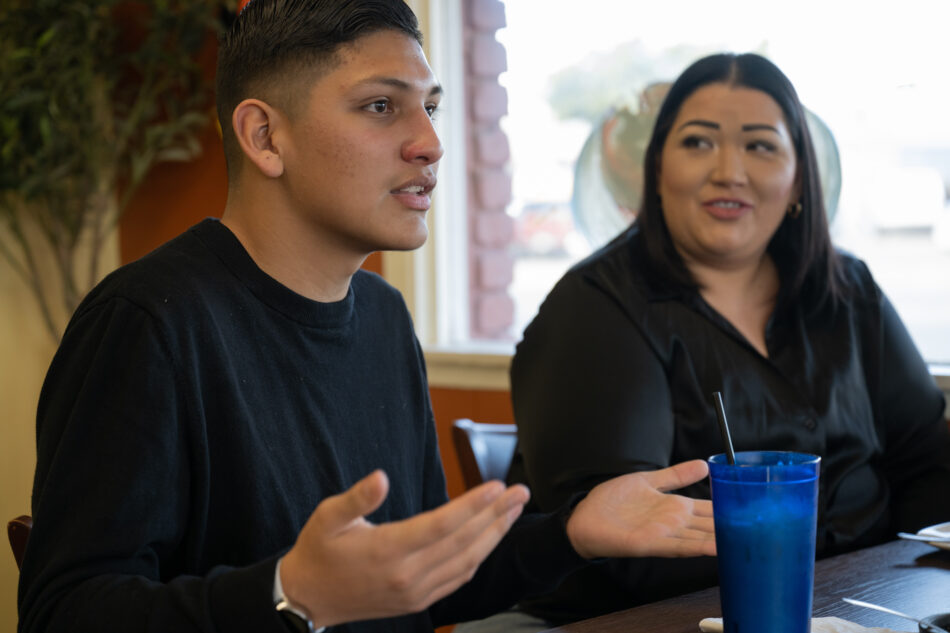
Victor (left) discusses pesticide exposure and activism as his mother (right) looks on. – Chris Schodt
Back in Greenfield, Victor sits across from me at El Michoacáno, a restaurant where he, his mother and other activists often gather to plan protests and prepare comments for government meetings. Over the background chatter of a telenovela and the clanging of the kitchen, he decries the dangers of pesticides, gesturing over half-finished cups of horchata. Almost six years after his fateful asthma attack, Victor, now sixteen, plans to graduate from Greenfield High School in spring 2024. Last night, he gave a talk to Berkeley law students about his experience as an activist for pesticide reform. The visit helped crystallize his dreams of going to law school and becoming a lawyer or politician to help ensure that people in communities like his might live and breathe a bit easier. This fight, he says, is a matter of life and death: “At the end of the day, all we’re asking for is for our basic human rights to live and to prosper.”
© 2023 Luis Melecio-Zambrano / UC Santa Cruz Science Communication Program

Luis Melecio-Zambrano
Author
A.A. (Biology track) Northwest Florida State College
B.S. (Chemistry) Stetson University
M.S. (Chemistry) Cornell University
Internships: Science News and California Local News Fellowship
The sequoias reached into the Kodachrome blue sky above the Sierra Nevada, towering over me like a counsel of immovable gods. They seemed invincible, but even they were at risk from climate destruction: Last year, a wildfire tore through Sequoia National Park, killing thousands of their centuries-old siblings.
I spent eight years working to prevent disasters like this as a chemist, but climate destruction did not wait for my long-term technological solutions.
I needed another approach.
I had failed to help save the sequoias through my research. But I can help people of all backgrounds understand our climate crisis. I can empower them to forge solutions. I can blend my scientific expertise with my writing to tell the world that we are losing so much, but there is so much left to fight for. I can show the sparks of hope amidst the flames.

Olivia Raster
Illustrator
B.A. (Environmental Studies) Western Washington University, Bellingham, WA
Art has always been integral to who I am. As a child, I was diagnosed with selective mutism. Consequently, my lack of verbal communication led me to explore art as a tool for expressing emotions. I discovered early on that I can better grasp information when connecting it to visual imagery. Although I have long since grown out of my mutism, expressing myself through art has remained. Growing up in Juneau, Alaska, I have drawn endless inspiration from my natural surroundings. Being immersed in such wilderness has fueled my passion for learning about the environment. I am thrilled to pursue a career which allows me to explore the relationship between science and art. This program will allow me to marry my fascination with science and the natural world with my artistic ability. In this way I believe I can best use my skills to educate and inspire others.
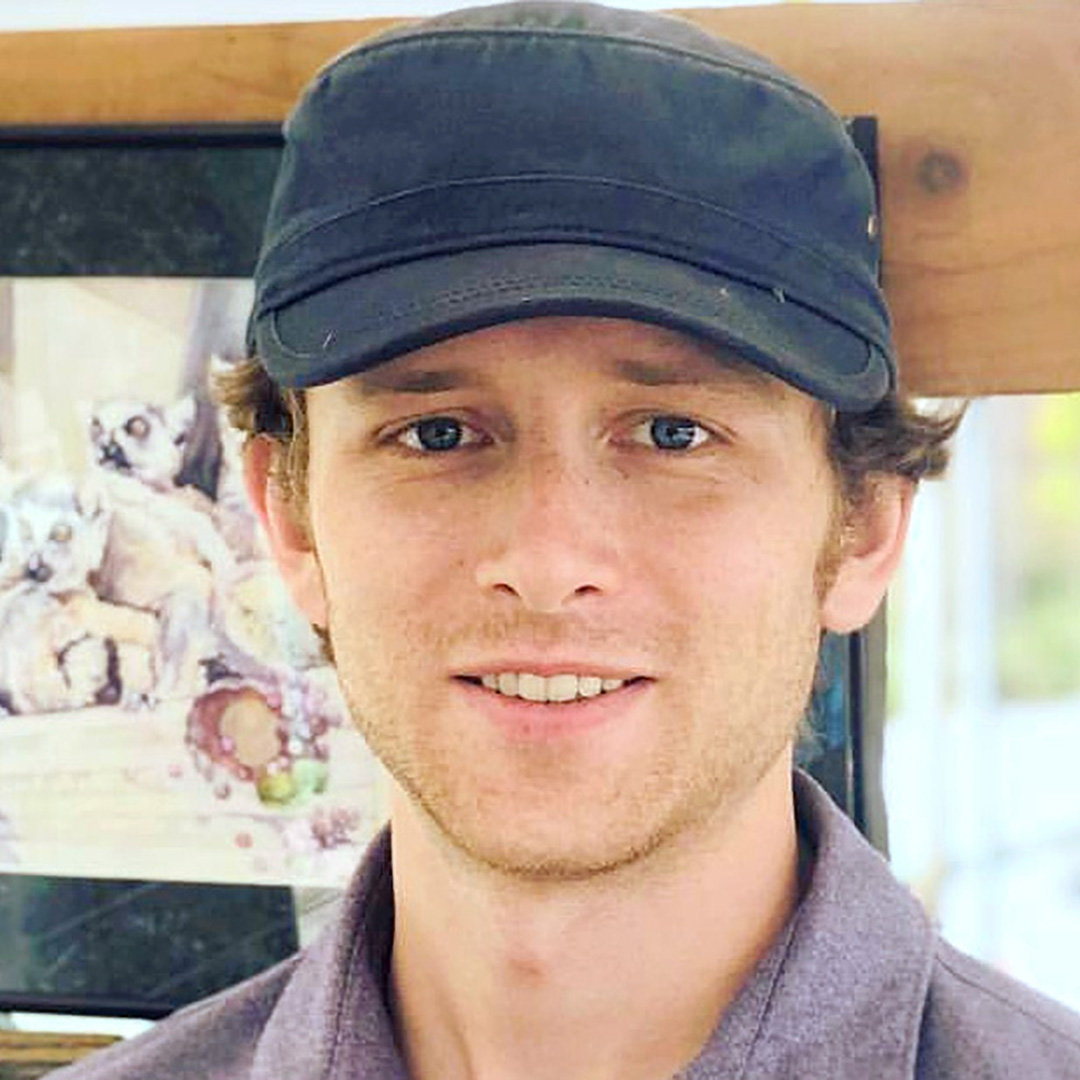
Jonathan Broberg
Illustrator
B.S. (Biology) California State University, Long Beach, CA
Internship: Learning Games Lab
Jonathan is a Science Illustration student at CSUMB. He was raised a San Diego farm boy, music nerd, and theater kid, but drawing animals was and remains his consistent obsession. He spent five years in community college, where he studied as an art major—until curiosity got the better of him and he added a science major to learn about animals and microbiology. He holds an Associate’s degree in Studio Art from MiraCosta College, as well as a Bachelor’s in Biology from Cal State Long Beach. He aspires to work in the science education field as an illustrator and animator.
Jonathan’s artwork can be described as off-beat and informative. His illustrations feature natural subjects sprinkled with whimsy, where humor facilitates discussions on biological relationships, behavior, and other natural phenomena. He is the most satisfied when a conversation can start with a painting and segue naturally to an explanatory graph or diagram. Watercolor is his main medium of choice, as it is both tactile and logistically compatible with a student’s tight schedule.